what ncauses a three way light to stop switching on two of the three lights
In building wiring, multiway switching is the interconnection of 2 or more electrical switches to command an electric load from more than i location. A mutual application is in lighting, where information technology allows the control of lamps from multiple locations, for example in a hallway, stairwell, or large room.
In contrast to a elementary light switch, which is a single pole, single throw (SPST) switch, multiway switching uses switches with one or more boosted contacts and two or more than wires are run between the switches. When the load is controlled from only ii points, single pole, double throw (SPDT) switches are used. Double pole, double throw (DPDT) switches allow control from three or more locations.
In alternative designs, depression-voltage relay or electronic controls can be used to switch electrical loads, sometimes without the extra power wires.
Iii-way and four-way switches [edit]

A double pole, double throw switch wired to human action as a four-fashion (intermediate or crossover) switch
The controlled load is often a lamp, only multiway switching is used to command other electric loads, such equally an electric outlet, fans, pumps, heaters or other appliances. The electrical load may be permanently hard-wired, or plugged into a switched receptacle.
Three-style and four-way switches make information technology possible to command a light from multiple locations, such as the top and bottom of a stairway, either finish of a long hallway, or multiple doorways into a large room. These switches appear externally similar to unmarried pole, single throw (SPST) switches, but have extra connections which allow a excursion to be controlled from multiple locations. Toggling the switch disconnects one "traveler" last and connects the other.
Electrically, a typical "3-style" switch is a unmarried pole, double throw (SPDT) switch. By correctly connecting two of these switches together, toggling either switch changes the state of the load from off to on, or vice versa. The switches may be arranged so that they are in the aforementioned orientation for off, and contrasting orientations for on.[1]
A "four-way" (intermediate) switch is a purpose built double pole, double throw (DPDT) switch, internally wired in manufacture to reverse the connections betwixt the input and output and having only iv external terminals. This switch has two pairs of "traveler" terminals that it connects either direct through, or crossed over (transposed, or swapped). An intermediate switch tin, still, be implemented past calculation appropriate external wiring to an ordinary (six terminal) DPDT switch, or past using a separate DPDT relay.
Past connecting i or more 4-mode (intermediate) switches in-line, with three-way switches at either finish, the load tin can be controlled from 3 or more locations. Toggling whatsoever switch changes the state of the load from off to on, or from on to off.
Two locations [edit]
Switching a load on or off from ii locations (for instance, turning a light on or off from either end of a flight of stairs) requires 2 SPDT switches. There are several arrangements of wiring to reach this.
Traveler system [edit]
In the traveler organisation, also called the "common" system, the electric line (hot, shown in crimson) is fed into the common terminal of one of the switches; the switches are so continued to each other by a pair of wires called "travelers" (or "strappers" in the Britain), and the lamp is connected to the common line of the second switch, every bit shown.
Using the traveler arrangement, there are four possible permutations of switch positions: ii with the lite on and two with the light off.
-
Off On 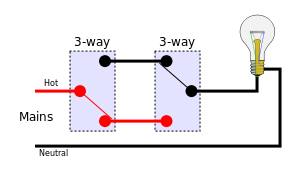
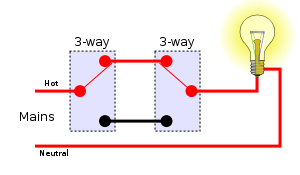


Alternative system [edit]

The "California three-way" or "Coast 3-fashion" connection never connects the lamp socket shell to the line (hot) terminal. An optional additional lamp tin can exist connected at Terminal A as a pilot lamp, or to illuminate a long corridor. An optional receptacle can be connected at Terminal B, since that concluding is always live.
An alternative arrangement, known every bit the "California 3-fashion", or "declension three-mode" connectedness organisation allows both switched and unswitched loads to be connected nearly both switches without running too many additional wires. This is useful in long hallways that may demand more than than 1 calorie-free to be controlled by the 2 switches, and which may also have receptacles needing unswitched ability also equally the switched lights. If simply one light is beingness switched and no unswitched connection is needed, this arrangement uses more long wires than the standard organization (four instead of iii), but if the switched light is shut to the switch almost the fuse box and a receptacle needs to be powered near the far switch it will use fewer long wires (four instead of five).
Carter organisation [edit]
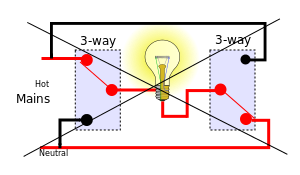
The Carter arrangement is prohibited in the U.s..
The Carter organisation was a method of wiring three-way switches in the era of early knob-and-tube wiring. This now-obsolete wiring method has been prohibited past the United states of america National Electrical Lawmaking since 1923,[two] even in new knob-and-tube installations which are still permitted under certain circumstances. This wiring system may still be encountered in old "grandfathered" electric installations.
In the Carter system, the incoming live (energized) and neutral wires were continued to the traveler screws of both three-mode switches, and the lamp was connected betwixt the common screws of the two switches. If both switches were flipped to hot or both were flipped to neutral, the light would remain off; but if they were switched to opposite positions, the lite would illuminate. The advantage of this method was that it used just 1 wire to the light from each switch, having a hot and neutral in both switches.
The major trouble with this method is that in one of the four switch combinations the socket around the bulb is electrified at both of its terminals even though the bulb is not lit. As the beat out may exist energized, even with the light switched off, this poses a hazard of electrical shock when changing the bulb. This method is therefore prohibited in modern building wiring.
More than ii locations [edit]
For more than 2 locations, 2 of the interconnecting wires must be passed through an intermediate switch, wired to swap or transpose the pair. Any number of intermediate switches can be inserted, assuasive for whatsoever number of locations. This requires ii wires along the sequence of switches.
Traveler system [edit]
Using iii switches, there are viii possible permutations of switch positions: four with the light on and four with the light off. Note that these diagrams also utilize the American electrical wiring names.
-
Off On 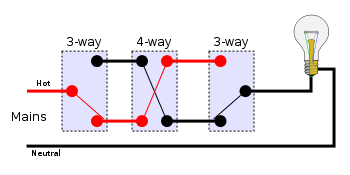
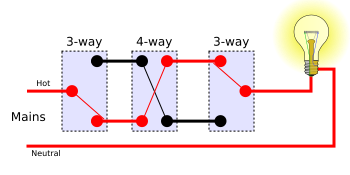
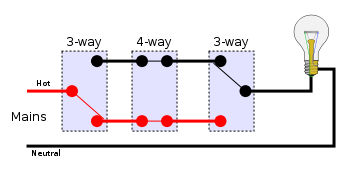
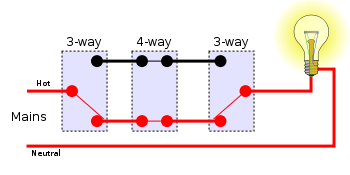

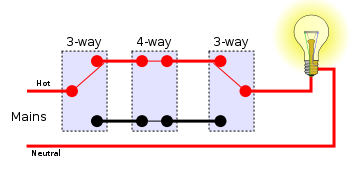

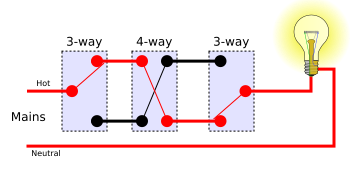
As mentioned above, the to a higher place circuit can exist extended by using multiple four-way switches between the 3-mode switches to extend switching ability to any number of locations.

Low voltage relay switching [edit]
Systems based on relays with low-voltage control circuits permit switching the power to lighting loads from an arbitrary number of locations. For each load, a latching relay is used that mechanically maintains its on- or off-state, even if ability to the building is interrupted. Mains power is wired through the relay to the load.
Instead of running mains voltage to the switches, a low voltage—typically 24 V Air-conditioning—is connected to remote momentary toggle or rocker switches. The momentary switches usually have SPDT contacts in an (ON)-OFF-(ON) configuration. Pushing the switch actuator in one direction causes the relay contacts to shut; pushing it in the opposite direction causes the relay contacts to open. Whatsoever number of boosted rocker switches can be wired in parallel, equally needed in multiple locations. An optional primary control can be added that turns all lights in the facility on or off simultaneously under the control of a timer or reckoner.
Later on an initial burst of popularity in the 1960s, residential use of such relay-based low voltage systems has become rare. Equipment for new installations is not commonly carried by electrical suppliers, although it is still possible to find parts for maintaining existing installations.
Electronic remote switching [edit]
Equally of 2012, multiway switching in residential and commercial applications is increasingly existence implemented with ability line signalling and wireless signalling techniques. These include the X10 system, available since the 1970s, and newer hybrid wired/wireless systems, such as Insteon and Z-Wave. This is peculiarly useful when retrofitting multi-manner circuits into existing wiring, often avoiding the demand to put holes in walls to run new wires.
Remote-control systems are increasingly used in commercial buildings as role of lighting systems under semi-automatic control, for better safety, security, and energy conservation.
References [edit]
- ^ "Can I wire 3-way switches then that when they are both in the same orientation the light will exist off?". Home Improvement Stack Exchange. 2014-12-22. Retrieved 2015-08-14 .
- ^ NEC Article 404.ii Switch Connections: (A) ... Iii-way and four-manner switches shall be wired and then that all switching is done only in the ungrounded circuit conductor ... (B) Grounded Conductors. Switches or circuit breakers shall non disconnect the grounded conductor of a circuit. Switching a neutral is generally forbidden past the NEC unless the hot usher is opened simultaneously
iii. how to wire a four-fashion switch
Farther reading [edit]
- Day, Richard (January 1987). "Wiring Multi Switches". Popular Science. 230 (1): 85+. ISSN 0161-7370.
- Litchfield, Michael & McAlister, Michael (2008). Taunton's Wiring Complete: Expert Advice from Start to Cease (revised ed.). Newtown CT: Taunton Press. ISBN9781600852565.
Source: https://en.wikipedia.org/wiki/Multiway_switching
0 Response to "what ncauses a three way light to stop switching on two of the three lights"
Postar um comentário